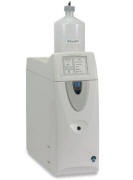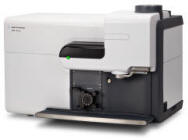Examination of soil, sediment, sludge quality
In our Laboratory we have developed a number of methods for testing soil quality and we strive for further development of new methods
The Laboratory for the Protection of the Working and Environmental Environment performs sampling, chemical and physical testing of samples:
- land
- sediments
- sludge
In order to determine the zero condition, pollution monitoring, landfill impact monitoring, impact monitoring of industrial and other facilities, etc., for which the Laboratory is accredited by the Accreditation Body of Serbia.
In our Laboratory we have developed a number of methods for testing soil quality and we strive for further development of new methods. In addition to the usual laboratory equipment, we also use microwave plasma – Agilent MP-AES 4100 atomic emission spectrometer, Agilent 7890A / 5975C gas-mass chromatograph (GC / MS), Dionex ICS 1100 ion chromatograph (IC), as well as gas chromatograph with Triplequad mass detector (GC – QQQ) Agilent Technologies 7890B / 7010, duo system of atomic absorption spectrometers with flame technique and graphite cuvette technique (AAS – FA, AAS – GF) Agilent Technologies 280FS AA / 280Z AA and microwave extraction digestion furnace Milestone Ethos Easy.
Soil analysis
By cutting the soil and taking the pedological profile, its physico-chemical and biological properties are revealed, such as texture, structure, granulometric composition, porosity, water permeability and others.
Sediment analysis
Sedimentation measurement involves sampling a mixture of sediment and water to determine the suspended sediment concentration, its specific gravity, the temperature of the mixture, and other physical and chemical properties.
Sludge analysis
We successfully determine the quality of sludge through analysis for heavy metals, polychlorinated biphenyls (PCBs), total organic carbon (TOC), dioxins and furans.
Competent team of experts and modern technology for precise analysis
Our chemical researcher or technician is responsible for sampling in accordance with accredited standard methods. The sample is then preserved, ie stored at low temperatures in the premises of our laboratory. Finally, the analysis process itself follows, the duration of which depends on the number of parameters and their individual microanalysis.
Depending on the determined properties and their coefficients, a clear picture of the possibilities or impossibilities of performing activities on certain areas is obtained. This ensures safety in the workplace, as well as its necessary sustainability in the future.
In our laboratory we have developed a number of methods for testing soil quality and we strive for further development of new methods. We work with the most eminent companies for the production of laboratory instruments such as Milestone Ethos Easy and Agilens Technologies.
The recommended monitoring of soil quality is once a year, during which the sampling and testing process is repeated. The work and training of our team on the most modern equipment for analytical operations guarantees fast and accurate results, and our many years of experience can help you find a solution to every problem.
Your reliable partner in the field of Environmental Protection - Zaštita "Beograd"

Agilent 7890A / 5975C gas mass chromatograph (GC / MS)

Gas chromatograph with triple quad mass detector (GC – QQQ) Agilent Technologies 7890B / 7010

Ionic chromatograph (IC) Dionex ICS 1100

Microwave plasma – atomic emission spectrometer Agilent MP-AES 4100

Microwave oven for digestion and extraction of Milestone Ethos Easy samples

Duo system of atomic absorption spectrometers with flame technique and graphite cuvette technique (AAS – FA, AAS – GF) Agilent Technologies 280FS AA / 280Z AA
Chemical and physical analyzes of soil, sediments and sludge that we offer:

- pH
- Dry matter and water content
- Total nitrogen
- Hummus
- Total organic carbon (TOC)
- Easily accessible phosphorus
- Easily accessible potassium
- Easily accessible sodium

- Naphthalene
- Acenaphthylene
- Acenaften
- Fluorine
- Phenanthrene
- Anthracene
- Fluoranthenes
- Pyrene
- Benzo (a) anthracene
- Crisis
- Benzo (b) fluoranthene
- Benzo (k) fluoranthene
- Benzo (a) pyrene
- Indeno (1,2,3-c, d) pyrene
- Dibenzo (a, h) anthracene
- Benzo (g, h, i) perylene

Phenols
- Fenol
- 2-Hlorfenol
- 2-Nitrofenol
- 2,4-Dimetilfenol
- 2,4-Dihlorfenol
- 4-Hlor-3-metilfenol
- 2,4,6-Trihlorfenol
- 2,4-Dinitrofenol
- 4-Nitrofenol
- 2-Metil-4,6-dinitrofenol
- Pentahlorfenol

- BHC-α
- BHC-β
- BHC-γ (Lindan)
- BHC-δ
- Heptahlor
- Aldrin
- Heptahlor-egzo-epoksid
- trans-Hlordan
- α-Endosulfan
- cis-Hlordan
- 4,4′-DDE
- Dieldrin
- Endrin
- β-Endosulfan
- 4,4′-DDD
- Endrin aldehid
- Endosulfan sulfat
- 4,4′-DDT
- Endrin keton
- Metoksihlor

Aromatic compounds
- Benzen
- Toluen
- Etilbenzen
- Ksilen
- Stiren
- Hlorbenzen
- 1,2-Dihlorbenzen
- 1,3-Dihlorbenzen
- 1,4-Dihlorbenzen

- Dimetil ftalat
- Dietil ftalat
- Diizobutilftalat
- Dibutilftalat
- bis-(2-Metoksietil)ftalat
- bis-(4-Metil-2-pentil)ftalat
- bis-(2-Etoksietil)ftalat
- Dipentil ftalat
- Diheksil ftalat
- Benzil butil ftalat
- bis-(2-n-Butoksietil)ftalat
- Dicikloheksil ftalat
- bis-(2-Etilheksil)ftalat
- Di-n-oktil ftalat
- Dinonil ftalat

metals
- Iron
- Manganese
- Chrome (total)
- Chrome (VI)
- Lead
- Cadmium
- Arsenic
- Copper
- Zinc
- Nickel
- Pine tree
- Alive
- Sodium
- Potassium
- Antimony
- Anjoni
- Nitrites
- Nitrates
- Chlorides
- Sulfates
- Phosphates
- Fluorides
- Bromide
